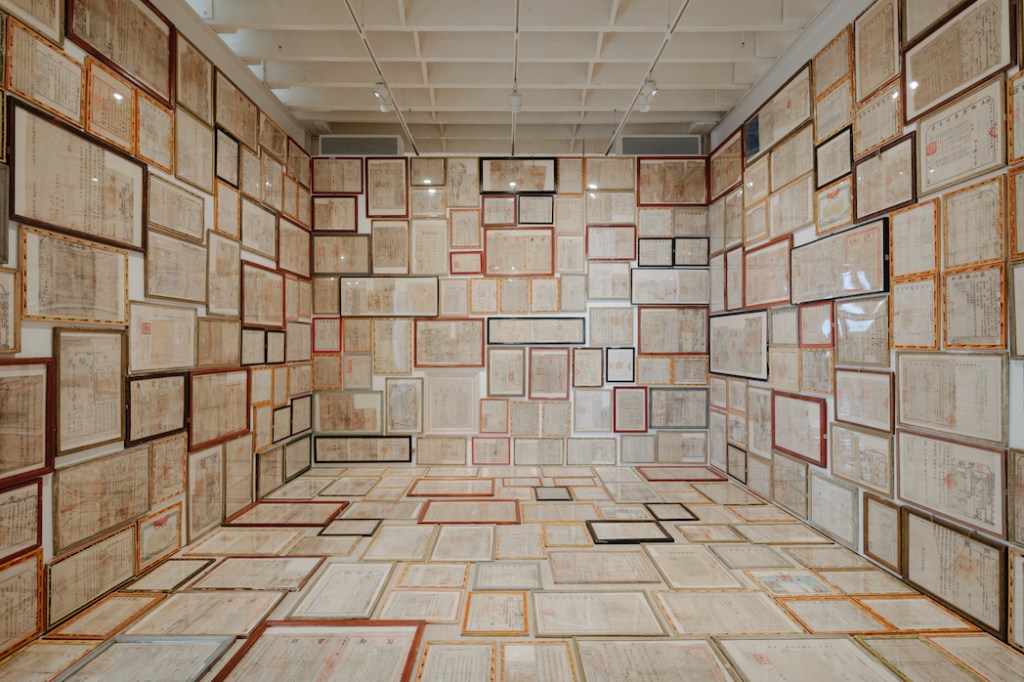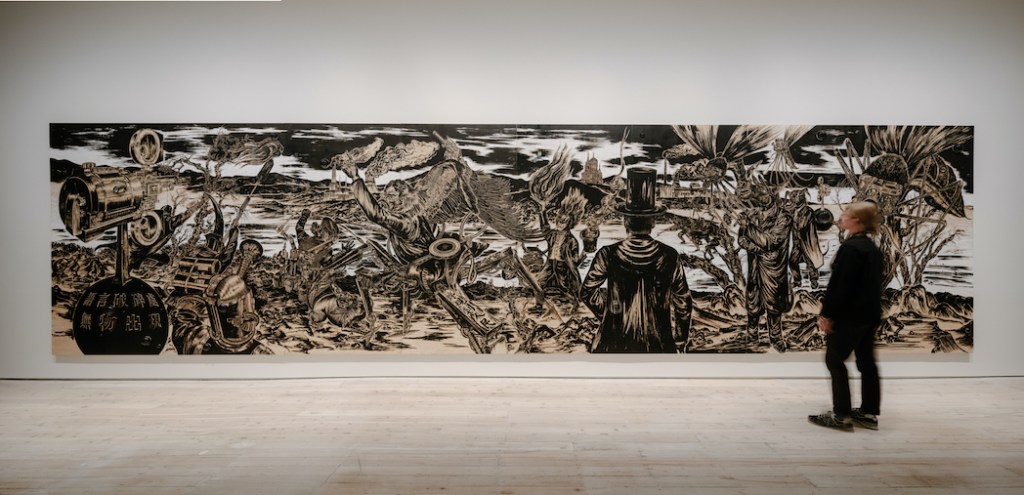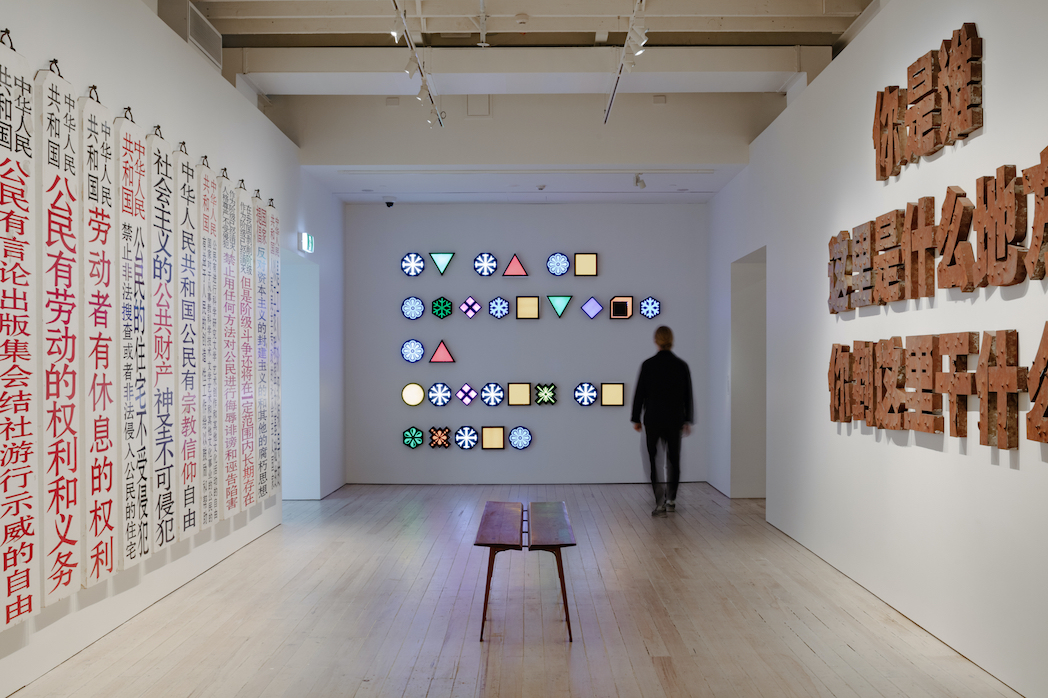For some years now, museum and gallery rhetoric has touted the importance of the role of storytelling. But let’s face it, storytelling is as old as time itself – indeed, White Rabbit Gallery places the history of the written word in China back 4000 years.
From traditional texts such as the Diamond Sutra, via Mao’s Little Red Book to street storytellers and contemporary artists using storytelling as social commentary, the power of the medium has held its value despite the introduction of technology and pressures of censorship.
Storytelling – or Shuo Shu 说书 – is the theme of a new exhibition curated by David Williams for White Gallery Rabbit (its 26th since opening in 2009), and draws together 29 artists from Judith Neilson’s private collection of 21st century Chinese art.
As with all White Rabbit Gallery shows, the exhibition is impressively large, both in its scale of artworks, but also its depth. A perfect example is a collection favourite, Liu Wei’s Density 1-6 (2013) shown on the ground floor. It has been crafted into books that have been glued together and then carved into monumental geometric forms, weighing up to 1500 kilograms each. Their muted tones are somewhat ghostly and mimic stone.
The gallery explains: ‘Density has a strange quality of emptiness – books that once contained a wealth of knowledge have been imprisoned within the huge forms, reduced to presenting blank surfaces onto which people must inscribe their own dreams and desires.’
That sentiment, to find our own stories in the work, carries across the exhibition. On the first level, we witness it again in the vacant books of Polit-Sheer-Form-Office Library (2008), comprising 7980 identical blue books neatly stacked on shelves. But unlike Mao’s Little Red Book, these tomes are devoid of political or indeed any content.
On this same level is a wonderful grouping of works by Wu Yuren, Meng Huan and Jin Feng (pictured top), who have each created installations of texts using different mediums.
Wu Yuren’s A Sentence (2012) presents a coded message from LED light boxes, its title referring both to his time in prison and his concerns about censorship in China. Decoded it reads, ‘It is an adventure living in China.’
Jin Feng has used the traditional-style red and black panels seen outside government buildings. His Signboard (2010), however, features phrases relating to human rights and freedom of speech taken from the Chinese Constitution, to show that there is no relationship between these texts and real life.
Meng Huang’s Rust (2009) presents three phrases: ‘Who are you?’ ‘What is this place?’ ‘For what purpose did you come here?’ It is said that in China guards shout these questions at prisoners, who must respond. Punctured by bullet points, the steel letters spell out a picture of state-sanctioned violence.
A sure standout in this exhibition is Mao Tongqiang’s installation Leaseholds (2016), which was made over three years and involved collecting 500 land title deeds to show the complexity of land ownership and land reform in China. The artists explain that the documents show that ‘all the revolutions in Chinese history were about fighting for land’.

Moving up to the middle level galleries, visitors take a journey through Sun Xun’s epic The Magic of Atlas (2017-ongoing), with a collection of concept drawings, costume and character designs, and storyboards as enormous woodcuts, for his animated film.

Equally epic in scale, it is paired with Yang Jiechang’s 20-metre painting on silk, Tale of the 11th Day (2012-14), which plays out a contemporary fairytale. Within it, humans and animals frolic, engaging in apparently mutually pleasurable cross-species sexual encounters. Its flattened stacked perspective pays a nod to traditional Chinese landscape painting.
And completing the exhibition in the upper level gallery, is Gu Wenda’s installation of marble stone-like forms, Tian Xiang: Forest of Stone Steles (Sixth Series) 2017, which are said to be millions of years old and quarried from a site in Shandong province – the birthplace of Confucius. Each of the 24 stones has been hand carved, and offers a critique of contemporary rhythms and cycles that disrupt the natural world and drive our lives.
Read: Exhibition review: Destiny Disrupted
Collectively these works, and others, open our minds to the ways we use and think about storytelling and text in our contemporary lives – what we perhaps take for granted and overlook, what we fail to question, what is being censored before our eyes, and how institutional voices shape our version of the world. As always with White Rabbit Gallery, it is a well presented exhibition with staff on hand in the spaces happy to strike up a conversation and extend the experience.
Williams concludes of the exhibition: ‘Artists become shapeshifters, and their stories twist and turn to fit within codes and secret messages.’ What, indeed, will you find in this exhibition’s secret messages?
Shuo Shu 说书
White Rabbit Gallery
Curated by David Williams
21 December 2022 – 14 May
Free.





